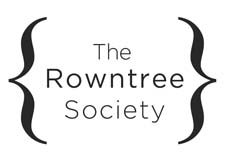Planning a traveling exhibition: My placement with The Rowntree Society
Posted on 27 April 2015
Daniel Johnson
MA in Public History, 2015
In 2014, The Rowntree Society, with a grant from the Heritage Lottery Fund (HLF), acquired 40 books, articles, and pamphlets written by or about Seebohm Rowntree. In perhaps the most comprehensive placement of the year, I was able to gain experience by planning a traveling exhibition with the collection. The placement allowed me to learn about all of the behind the scenes work that goes into developing the exhibition. Although I ‘dipped my toes’ into almost every aspect of the planning and curating process, including reading multiple books about how to write exhibition boards and object labels, most of my work revolved around developing the plan for the exhibition, researching interesting stories to accompany the collection, and drafting a press release for the HLF website.
When I was assigned this task, I felt like I was thrown into the deep end. Although it was a scary task, I had a lot of support from the Project Director and with a little help from Google, I was able to find a business plan template and alter it to the needs of the project. The plan expressed the goals and expected outcomes of the project, the budget, and the exhibition design plan. I also attached appendices of research on a number of potential hosts from around the UK and a list of important and interesting quotes from a number of the books in the collection that could be used for advertising and informative purposes in the future.
I researched their potential hosts to see if they matched the business management and social reform aspects of the exhibition, and also looked to see if they had a high chance of accepting the exhibition. Audience was the major focus throughout the project. I understood that the exhibition revolved around Seebohm as a business management pioneer and an important social reformer who fought for ending poverty and the enactment of a national minimum wage. Once the hosts were researched, I was responsible for writing a letter to them asking if they would host our exhibition (as of right now, a few have responded with a yes!).
Once the plan and host letters were sent, I began researching stories to accompany the books in the exhibition. We needed to make them exciting by showing the themes they represented and the stories they told.

Seebohm Rowntree was the Director for Rowntree’s from the 1890s into the 40s, but he is famous for studying poverty in the UK. He was a major social reformer and became one of David Lloyd George’s most trusted advisors while he was the Prime Minister. While digging into researching Seebohm for the exhibition, I found a picture of him in Japan. After spending some quality time in the archives and scouring the darkest corners of the library, I was able to find out that he was in Japan because he wanted to expand his chocolate empire there to compete the growing international reputation of Rowntree’s rival, Cadbury.
After I found a number of interesting stories in addition to the ones about Seebohm and Lloyd George and Seebohm in Japan, I was tasked with drafting a press release to go on the HLF website. It took a number of drafts and a lot of editing from the Project Director, but the press release was published on the website and was one of the major accomplishments for my placement. It was great to get recognition for my hard work and is something that I can use to boost my CV and confidence as a Public Historian.
This placement was a great experience for me that I am already benefitting from. I have used this experience to get my foot in the door volunteering with a number of museums around York and even further afield in Blackpool. The placement has given me confidence in my abilities as a Public Historian and will greatly contribute to finding a job after graduation. I recommend the placement to any History MA at the University of York.

